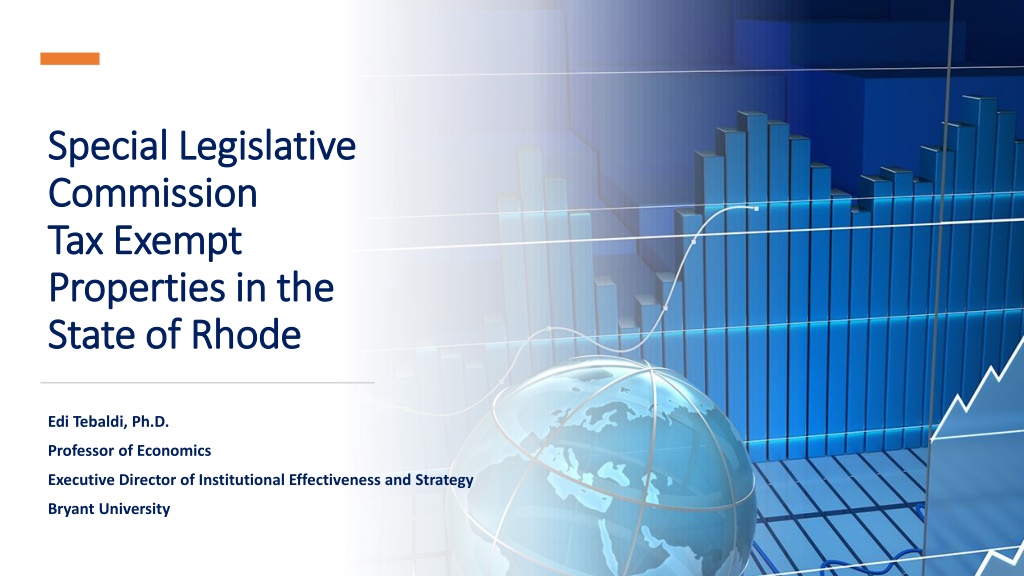Impact of Nonprofits in Rhode Island: A Comprehensive Overview
Nonprofits play a crucial role in Rhode Island, contributing significantly to the economy, job creation, and community development. They attract and retain disadvantaged communities, support the arts, provide essential services, drive economic growth, and enhance cultural awareness. In 2021, nonprofits generated over $3.9 billion in wages and approximately 67,000 direct jobs in Rhode Island. Cities and towns compete for nonprofits, recognizing their value as key players in the market economy.
Download Presentation

Please find below an Image/Link to download the presentation.
The content on the website is provided AS IS for your information and personal use only. It may not be sold, licensed, or shared on other websites without obtaining consent from the author. Download presentation by click this link. If you encounter any issues during the download, it is possible that the publisher has removed the file from their server.
E N D
Presentation Transcript
Special Legislative Special Legislative Commission Commission Tax Exempt Tax Exempt Properties in the Properties in the State of Rhode State of Rhode Edi Tebaldi, Ph.D. Professor of Economics Executive Director of Institutional Effectiveness and Strategy Bryant University
Nonprofits are vital to a well Nonprofits are vital to a well- -functioning market economy and to promote development economy and to promote development functioning market Attract and Retain Disadvantaged Communities Support the Arts Educate and prepare Development Healthcare Make the state an attractive place to visit, live, and do business Provide voice, services, and resources to meet the needs of disadvantaged communities Drive economic development Enhance the arts and cultural awareness Educate and prepare people to be productive citizens Provide health services
Cities and Towns should be Cities and Towns should be competing for nonprofits as they do competing for nonprofits as they do for other businesses for other businesses
Impact of Nonprofits in Rhode Island,2020 Nonprofits Registered with IRS in 2020 Metric Rhode Island City of Providence Number 5,407 2,541 Assets $38.9 billion $23.6 billion Revenue $13.9 billion $8.3 billion Source: Author s using IRS Data
Data presented are preliminary estimates Disclaimer
In 2021, Nonprofits generated approximately 67,000 direct jobs direct jobs and over $3.9 billion in wages in Rhode Island Employment, Nonprofits, 2021 Total Wages, Nonprofits, 2021, $ Billion $2.34 45,000 2.5 Rhode Island Providence County 38,485 Rhode Island Providence County 40,000 2.0 35,000 $1.63 30,000 26,722 1.5 25,000 $1.07 17,177 20,000 1.0 13,719 $0.69 $0.68 15,000 $0.47 9,883 0.5 10,000 6,246 $0.04 $0.03 5,000 1,394 455 0.0 0 Health Care and Social Assistance Education Arts, Other sectors Health Care and Social Assistance Education Arts, Other sectors Entertainment, and Recreation Entertainment, and Recreation Source: Author s estimates using U.S. BLS Data QCEW
Nonprofit Circular Flow Diagram Generates income tax revenues Generates income tax revenues Household income Direct income Induced effect Indirect effect Induced Effect Direct Employment Education Healthcare Grantmaking Other nonprofits Indirect employment Induced employment Demand for goods and services from local businesses Indirect effect Induced Effect Direct Purchases Local vendors and suppliers Generates income tax revenues Demand for additional labor and for goods & services from supply chain Direct spending Exempt of Sales-tax Accrues sales-taxes
Nonprofits Total Impact* ~ 115,000 jobs and $6.4 Billion in wages Source: Author s using IMPLAN and BLS Data QCEW *Preliminary estimates subject to revision
Nonprofit Tax Impact, Rhode Island (Preliminary estimates subject to revision) $ Million (annual) 114.2 Metric Direct/Indirect/Induced Personal Income Taxes Accrued by the State Indirect/Induced Corporate Income Tax 10.9 Indirect/Induced Sales Taxes 134.1 Indirect/Induced Property Taxes 203.7 Accrued by Cities and Towns Indirect/Induced Motor Vehicle Licenses/fees 2.7 Other Fees and Taxes 34.2 Total 499.8 Source: Author s using IMPLAN and BLS Data QCEW
Nonprofit entities: Produce significant benefits to all Rhode Islanders: ~ 115,000 jobs and $6.4 Billion in wages Generate and support tax revenue through multiple channels: Approximately $500 million in total tax/fees revenue contribution to the State, Cities, and Towns in Rhode Island The State Government collects approximately $250 million in income tax, corporate income tax, and sales tax revenues created/supported by nonprofits activities.
Nonprofit entities: Produce significant benefits including jobs and income to all Rhode Islanders. Generate tax revenues that are mostly accrued by the state government Cost versus Benefits Cities/Towns bear most of the burden/costs to provide services to support for-profit and Nonprofit organizations; Partially reimbursed via annual discretionary appropriations (State Pilot - $46 million in FY 2022) Political reality: Cities/towns see nonprofits as an untapped source of new revenues: new taxes, fees, and PILOTs. Context
Opportunity Current model: Annual discretionary appropriations process via the State PILOT Risk that amounts can change significantly Linked to real estate tax assessment and to all issues related to tax assessment Delinked from economic contributions -- including income tax revenues -- made by nonprofits Alternative model: Mandatory reimbursement via a compensatory formula based on economic contributions to the economy Proposal: Rhode Islanders would benefit by implementing a model in which income tax revenues generated by Nonprofits would be shared with cities and towns hosting these entities. Linked to economic contributions made by nonprofits Minimizes risk associated with discretionary appropriations (less volatile) Delink reimbursement from real estate tax assessment and State Pilot
Proposal: Eliminate State PILOT and Create a statewide Nonprofit Income Tax Revenue Sharing Formula Guiding Principles to develop Nonprofit Tax Revenue Sharing Formula For all Rhode Islanders Be transparent, consistent, equitable and of benefit to all Rhode Islanders. For Cities and Towns Share income taxes that are generated/supported by nonprofit activities and collected by the state government Support cities and towns to attract nonprofit entities For nonprofits Foster a stable and predictable environment for growth of Nonprofits Protect nonprofits from arbitrary demands and/or increases in fees or PILOTs by local cities and towns. Should be simple and objective Utilize nonprofit payroll to estimate income tax generation Formula should be developed as to ensure that total reimbursement would not be smaller than that from current State Pilot Work/implement like school-funding formula























